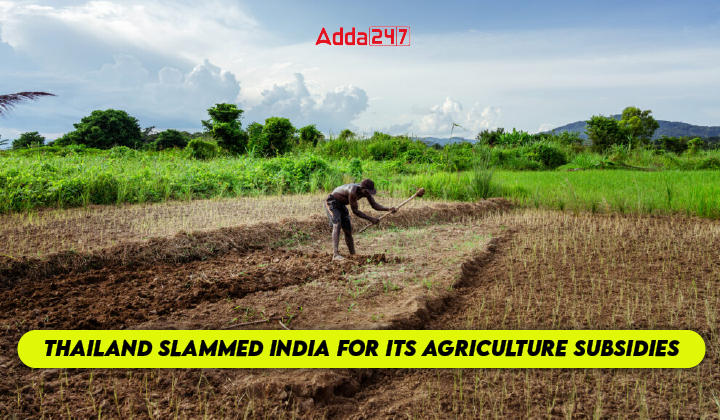Table of Contents
Thailand has appointed a new ambassador to the World Trade Organization (WTO) following objections from New Delhi regarding the former ambassador’s remarks about India’s Public Stockholding (PSH) program.
Relevance: GS 2 and GS 3- International Relations, Food Subsidies, World Trade Organization.
Why is Thailand Concerned about India’s agriculture subsidies?
- After India, Thailand is the second largest rice exporter in the world.
- Pimchanok Vonkorpon Pitfield criticized India’s rice procurement program and argued that the Public Distribution System (PDS) aims at dominating the export market rather than serving the populace.
- Cairn group has repeatedly criticized India’s PSH (Public Stockholding) program at the WTO.
- They claim the program is excessively subsidized, distorts global food prices, and negatively impacts other countries’ food security.
- The WTO stipulates that product-specific support should not surpass 5% of the total production value of the agricultural product concerned.
- For developing countries like India, the de minimis ceiling is set at 10%.
- India has exceeded this 10% de minimis limit for rice.
-
Thailand belongs to the Cairns Group, a coalition of 20 countries.
-
The Cairns group comprises Argentina, Australia, Brazil, Canada, Chile, Colombia, Costa Rica, Guatemala, Indonesia, Malaysia, New Zealand, Pakistan, Paraguay, Peru, Philippines, South Africa, Thailand, Ukraine, Uruguay, and Vietnam.
This overreach has frustrated other rice-exporting nations like Thailand, who struggle to compete with Indian rice and are losing their share of the global export market. WTO rules mandate that agricultural subsidies should not exceed the 10% de minimis limit.
WTO Agreement on Agriculture
The World Trade Organization (WTO) categorizes subsidies under its Agreement on Agriculture into several “boxes” based on their potential to distort international trade.
Amber Box
- Definition: Amber box subsidies are those that have the potential to distort trade by making a country’s products more competitive than those from other countries due to direct government support.
- Examples: These include subsidies for agricultural inputs like fertilizers, seeds, electricity, and irrigation, as well as support prices for products, such as Minimum Support Price (MSP) schemes.
- WTO Rules: Under the WTO, amber box measures are subject to reduction commitments. Countries have agreed to reduce these trade-distorting supports to agreed-upon levels.
- Limits: The “de minimis” provisions allow countries to provide subsidies up to certain thresholds without having to reduce them:
- Developing Countries: Up to 10% of the value of agricultural production.
- Developed Countries: Up to 5% of the agricultural production value.
Blue Box
- Definition: The blue box is essentially the amber box with conditions. These conditions are designed to reduce the distortionary potential of the subsidies.
- Characteristics: Subsidies that require farmers to limit production fall into this category. This can involve production quotas or land set-aside requirements where farmers are paid to not plant part of their land.
- Limits: Currently, there are no spending limits on blue box subsidies, making them a more flexible option for countries looking to support their agricultural sector without breaching their WTO commitments.
Green Box
- Definition: Green box subsidies are those that are considered to cause minimal or no distortion to international trade.
- Characteristics: These subsidies are government-funded but do not involve price support for specific products. They are aimed at achieving various policy objectives, such as environmental protection, research, disease control, infrastructure development, and food security.
- Examples: Direct income supports for farmers that are not related to production levels or prices, and government-funded programs for environmental conservation, pest and disease control, and infrastructure and food security.
- Limits: Green box subsidies are allowed without limits, provided they comply with the criteria set by the WTO to ensure that they do not distort trade.
WTO rules mandate that agricultural subsidies should not exceed the 10% de minimis limit.
- India reported to the WTO that its rice subsidies in 2019-20 were 13.7% of its rice production value, exceeding the allowed 10%.
- This breach goes against the allowances made under the 2013 Bali Agreement, designed to protect developing countries from subsidy level challenges.
- The Bali Agreement’s protective measures are tied to stringent conditions, including comprehensive notification requirements, making them hard to implement.
What is India’s argument and demand at the WTO?
- India argues its farm support is significantly lower than that of developed countries like the US and EU.
- The subsidy per farmer in India is $300, versus $40,000 in the US.
- India challenges the WTO’s subsidy calculation method, which uses fixed 1986-88 prices, leading to subsidy overestimation.
- India is pushing for a revision of this calculation method in WTO’s agricultural negotiations
Conclusion: Despite discussions, the 13th Ministerial Conference of the WTO concluded without a resolution on a permanent public stockholding solution. The Cairns Group criticizes the ‘peace clause’ activated by India’s breach of the de minimis limit, seeking more flexibility in farm support.



 TSPSC Group 1 Question Paper 2024, Downl...
TSPSC Group 1 Question Paper 2024, Downl...
 TSPSC Group 1 Answer key 2024 Out, Downl...
TSPSC Group 1 Answer key 2024 Out, Downl...
 UPSC Prelims 2024 Question Paper, Downlo...
UPSC Prelims 2024 Question Paper, Downlo...




